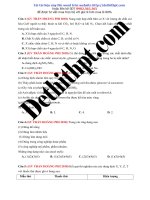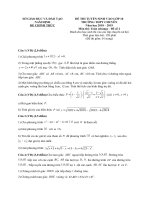Cs224W 2018 52
Bạn đang xem bản rút gọn của tài liệu. Xem và tải ngay bản đầy đủ của tài liệu tại đây (6.78 MB, 9 trang )
Reducing Influenza Propagation Through Air Travel
Pathways*
Juan Ricardo Grau!
and Marisa Pia Kwiatkowski
Abstract— During ”flu season’, influenza, a common
infectious disease, spreads rapidly across the United
States and throughout the world. In this work, we explore
methods to curb the spread of the flu throughout air
traffic networks, a frequent culprit of flu transmission.
Using link-removal of edges in real air traffic network
datasets, we model a delay of the spread of the flu
throughout the network. In this work, we analyze some
of the existing methods for link-removal that use properties inherent to the network, including Jaccard index,
betweeness centrality, and MinAtRisk, and evaluate their
performance using discrete-stochastic simulations. We
use these methods to create simulations to measure
impact, and look toward optimal ways to inhibit the
spread of infection through networks.
I. INTRODUCTION
A. Background on Influenza
Influenza, commonly known as the flu, is a mild
to severe upper respiratory virus that infects people
across the world, hitting the United States particularly hard between December and March. Because
of the virus’ swift ability to mutate and resulting
mismatch between the vaccine specimen and the
circulating virus, the flu vaccination doesn’t fully
protect against illness. Thus, in the US winter of
2017-2018, approximately 900,000 people were
hospitalized from the flu and 80,000 deaths occurred from the flu and related complications [1].
In general, the flu is easily transmitted
through human-to-human interactions, with virus
molecules caught in water droplets from coughs or
sneezes
or transmitted via surfaces.
Furthermore,
people infected with the flu are most contagious a
day before the start exhibiting symptoms, increas*Project for CS224W, Stanford University
'J. Grau is with the Department of Computer Science, Stanford
University. jrgrau
at stanford.edu
2M. Kwiatkowski is with the Department of Computer Science,
Stanford University. marisapi
at stanford.edu
ing the chances of flu spreading unbeknownst to
the host.
B.
The Airport Problem
The spreading patterns of the flu make public
places danger zones for flu transmission. In particular, airports are a prime breeding ground for the
virus, because of the sheer number of people from
different origins and different destinations that pass
through airports daily, and the close proximity of
people in the airplane’s closed environment.
There are a variety of ways in which flu
transmission can be curbed throughout the airport
system.
On
the
individual
scale,
these
methods
include: preventing or discouraging people with
visible symptoms from flying, cleaning and disinfecting public surfaces, and providing masks for
people on flights. Zooming out, on a higher level,
these include: cancelling flights and shutting down
airports to see more widespread impact.
Looking at the ways in which flu propagation
can be curbed,
we
can help
set the groundwork
for protecting people across the world from other
serious epidemics, ones that spread faster or have
a higher infection rate, and where swift action can
be critical to saving lives.
Overall, we will look into existing methods such
as the Jaccard index and betweenness centrality
to selectively remove the links which are most
susceptible to transmitting diseases and evaluate
them on real flight-traffic network data subsets.
Based on these methods, we compare various ways
of modeling spread and inhibiting the spread of
infection.
Il.
A.
RELATED
WORK
Link Removal
There are several existing papers attempting to
accomplish the task of reducing flu transmission
through link removal.
In 2014, Nandi and Medal used mixed-integerprogramming formulations (instead of the nonlinear formulations used in other papers) of different models to inhibit the spread through a
network
[2]. The
first two
models
are aimed
at
optimizing the number of connections between
nodes. These models are the MinConnect model,
which minimizes the connections between infected
and susceptible nodes, and the MinAtRisk model,
which minimizes
The second two
mission paths in
tries to maximize
the number
models try
the network.
the number
of susceptible nodes.
to optimize the transThe MinPaths model
of transmission paths
removed from the network, while the MinWPaths
model tries to minimize the weighted number of
transmission paths between all infected nodes and
all susceptible nodes. They implemented greedy
algorithms for each of these models which allow
them to get within 5 percent of the optimal solution with a reasonable run time. They compare
their four different models in a variety of starting
simulations. Each simulation starts with a different
percentage of infected nodes and they are allowed
to remove only a certain percentage of links.
They compare their models with a model that
randomly deletes edges, a model that greedily removes links with the highest contamination degree,
and a model that removes based on betweenness
centrality scores.
One flaw in this paper is that all of the networks
that they tested their algorithms on were artificially
generated. As a result, it is difficult to draw a result
that could apply to real-world situations such as
the spread patterns of real infectious diseases over
flight networks. On a purely mathematical basis,
their methods
seem
to work
well.
However,
the
simulations they use (susceptible-infectious and
susceptible-infectious-recovered) are quite simplistic. In their simulations, nodes will infect a neighboring node with a pre-determined transmission
probability.
In
built
addition, in 2012, Marcelino and Kaiser
on the research behind link removal [3].
Similar to other contemporary papers studying flu
spread in airline networks, they recognized that
removal of hubs or high-traffic airports is not
the
most
practical
solution,
and
instead
worked
to identify key flights and remove those so as to
cause less of a disruption on the system. They
also modeled the spreading of HIN1 through the
network, taking into account the population of the
airports surrounding cities, time for the flu to be
at peak infection power, and interactions between
individuals. For the edge removal strategies, they
employed a model to remove a certain amount
of connections depending on characteristics of the
edges using betweenness centrality and the Jaccard
coefficient. With a target of removing 25 percent of
the connections and measuring impact, the results
showed a decrease in infected population of 37
percent for edge betweenness centrality and 23
percent for the Jaccard coefficient, compared to
only 18 percent for the hub removal strategy [3].
This paper has limitations, including computationally heavy measurements, a limited data
set that treats all airport connections with equal
weights and frequencies, and unrealistic assumptions of the flu originating in Mexico city, when in
reality its likely that the flu enters the airline network from multiple starting places and spreads in
parallel from those multiple origins. We overcome
some of these limitations in our work.
B. Betweenness Centrality
Focusing in on using betweenness centrality as
a metric,
in 2001,
for
vertex,
Brandes
discusses
new
meth-
ods of optimizing for betweenness centrality [4].
Brandes outlined the method of determining central nodes by looking at nodes that are hit in
the most shortest paths between all start points
and end points on the graph. The article also
makes comparisons to other centrality measures including: graph centrality, closeness centrality, and
stress centrality. Brandes introduces the concept
of dependencies of one node on another when
calculating shortest paths which means that one
can determine the betweenness centrality index by
solving one single-source shortest-paths problem
each
a great
improvement
[4].
And
another tactic for increasing speed is to split the
graph into biconnected components and solving for
those first. Brandes also provided evidence based
on real tests for the algorithms developed in the
article.
Overall, Brandes tested these new algorithms
and measured the speed on undirected and un-
weighted random graphs as well as on one
weighted directed graph. However, it would be
more helpful to see if this holds for not only randomly generated graphs and the naturally-occuring
social
network,
but
also
real
human-engineered
networks like flight patterns, and on diverse sets
of data with both high and low clustering / density
/ diameter / etc. The network sample that these
tests were run on also had a low density and low
out degree on average for nodes, making harder to
extend this runtime optimization to other network
types, and making the evaluation less robust or
realistic for this case.
Ill.
A.
Data
METHODS
Collection
We gathered our data from two sources. First,
the sample data set used in the Marcelino study
with 500 global airports, and second,
a weighted
network of flights between US airports in 2002,
weighted by available seats between two airports
over the course of the year.
Having data from both of these sources was
helpful for comparison, both between a global and
US dataset, and between the constructed weighted
and unweighted networks from these two sources.
Working with both of these sources allowed for a
wider view of general flu persistence and growth,
in conjunction with the effects of edge removal.
B.
run in reasonable time on a graph with 500 nodes
and thousands of edges (this was also mentioned
by Nandi et al. [2]). While this graph is not as
accurate of a representation of our problem as the
US airlines weighted graph or the global airline
graph, we thought it would give us a sense of how
the min-at-risk algorithm would compare to our
other link removal methods in reducing the number
of infections of the flu virus. The random graph
is directed and unweighted, and generated as an
Erdos Renyi random graph.
C. Equations
Nandi et al. model the problem of inhibiting
the transmission of a virus through a network
as a mixed-integer-program, where the goal is to
minimize the number of susceptible nodes in the
network by repeatedly removing edges [3]. They
refer to this approach as the MinAtRisk model.
The MinAtRisk mixed-integer-program is as follows:
min
x
sí.
x¡;+y¡; > 1 VỤ,j) CA
Xki —Xkj +yYij 2 O V(k,i) € Q, Vj EN,
}, vụ
vỡ
(i,j)€A
Network Construction
The first step was constructing the network
structures from the data sets, using the Snap.py
and NetworkX frameworks. To work with the
Marcelino unweighted global dataset, we processed the csv files downloaded from the research
site. To work with the US weighted dataset, we
created loaded the edge list, and stored alongside
it, a separate dictionary of edges to their respective
weights (weights calculated from amount of traffic
along that flight path). We calculated constant
metrics for both of the two graphs, using the edge
weights for the weighted graph, allowing us to
compare the two.
We decided to also test our link removal methods on a randomly generated graph with 50 nodes
and 150 edges. We decided to do this after we discovered that the min-at-risk algorithm would not
k#j,Jj#1
Xij
>0
Ví, j)
EQ
yij € 0,1 Vi,
Z—+%¡; >0
j)EA
ViC §, jCI
While Nandi et al. don’t explicitly solve this optimization problem, they present a greedy algorithm
to solve it in a more reasonable amount of time.
D. MinAtRisk Algorithm
We
use
the
Greedy
Algorithm
to solve
this
MinAtRisk problem [2]. In this algorithm, we take
a set of infected nodes 7, a budget for how many
edges we are allowed to remove b, and the number
of times we are going to randomly remove a set of
links M. In [2], J has a predetermined size and is
then randomly selected from N, and M is always
set to 100. The set of susceptible nodes S is the
Algorithm 1 Greedy Algorithm to minimize the
number of nodes at risk of infection in a network
1: procedure
GREEDY MINATRISK(G)
đ:
3:
4:
I© set of Infected nodes in N
b + number of edges to remove
M + sample size
5:
L0
6:
7:
8:
9:
10:
H1:
12:
<0
for 7c [I,M] do
TL+b-—|L|—1
EcE\TL
Re,
TRe, <—TRe, + Rez,
{E¡j|¡ € I and
E=ELJE;
17:
18:
if TRe, < TRoesy then
Ibest — 1
21:
JES}
h«&-EUTL
16:
20:
the shortest path between
two
Rand edges
14:
15:
—
network,
vertices is the path that minimizes the total sum of
the edge weights along the path.
The betweenness centrality of a vertex v in a
network is given by the following formula:
13:
19:
weighted
while |L| < b do
for ¡c [I, |E|] do
E
in a network. The betweenness centrality score
calculates the importance of a node or edge using
the concept of ’shortest paths.’ In an unweighted
network, the shortest path between to vertices is
the path that traverses the fewest edges. For a
L
EC E\E ing
return L
The betweenness centrality of a vertex is a
measure of how many shortest paths that pass
through a given node. Similarly, the betweenness
centrality of an edge in a graph is the number of
shortest paths that traverse that edge. Here, we
will use edge betweenness centrality to provide
fewer disruptions to the airline networks (removing nodes would equate to shutting down entire
airports, which would be a large disruption for
travellers).
set of all nodes that have one or more connections
to an infected node.
Essentially, this algorithm goes through all the
edges of the network, and removes the edges that
contribute most to the number of at risk nodes. At
each iteration of the while loop, we remove the
edge that results in the greatest decrease in the
number of susceptible nodes when it is removed
from the network.
(See Algorithm
F. Jaccard Coefficient Algorithm
Marcelino et al. also remove edges based on
their Jaccard coefficient. The Jaccard coefficient
between two neighbors is given by the following
formula:
J
1)
It is important to note here that we do not
remove any edges that would disconnect the graph.
We decided that it is important for the graph to
stay connected to make sure people can travel
between any two vertices in the graph. This applies
both to the MinAtRisk algorithm and also to all
subsequent link-removal methods - betweenness
centrality and Jaccard algorithm.
E. Betweenness Centrality Algorithm
One measure used by Marcelino et al. to determine which edges to remove from the network is
betweenness centrality. Centrality scores are meant
to measure the ’importance’ of vertices or edges
(x,y)
_— 0T;
|
|ITxUT;|
Where I. is the set of neighbors of a node x.
This is defined for undirected graphs, but since we
are dealing with directed graphs, we needed a way
to modify this so that it applies to the networks
we
are using.
So,
instead
At the moment,
we
can
calculate
we
calculate
separate Jaccard coefficients for in and out degrees.
of using
just
I,,
two
coefficients, the first using I’,,in (ie: neighbors of
x that have edges ending at x) and the second
using [,,out which is similarly defined. We try
multiplying these coefficients together to create a
Jaccard coefficient for each edge, but plan to look
into other ways of distilling these two values into
a similarity measure.
G.
given
Model
In order
to see
the link removal
flu
spread
of Epstein
the
change
interventions,
simulation
et al.’s 2007
model
model
before
we
based
and
after
constructed
loosely
[6]. We
use
a
off
the
weighted and unweighted networks of airline traffic separately to predict spread of travellers, and we
use these alongside stored data about the current
number of people in a city who are flu infective,
as well as the total number of people in a city who
have been infected throughout the duration of the
simulation. We will detail the algorithm for our
model in the following sections.
In our model, we use a Susceptible-InfectiveRecovered (SIR) model because, even though the
flu can mutate, making it SIS in the long-term,
it’s almost impossible for it to change drastically
enough to cause someone to become infected twice
within the 30-day time frame of our simulation.
Therefore,
similar
to Epstein
et al., we
look
at
the infective period as the 1 day when a person
is infected with the flu, but not yet exhibiting
symptoms. This is because on this 1 day, they are
the most contagious, and may unwittingly spread
the flu during travel. In contrast, when they have
visible symptoms, they are much more likely to
remain in their homes and postpone travel plans,
because the flu is more severe than say a common
cold. Therefore, we use this 1-day infective period
for our model
[6].
We also use the reproduction number of 1.7
from the Epstein et al. paper, to remain consistent for comparison in the field. We calculate
the expected number of additional people infected
per day, B, using the definition of reproduction
number, Ro, where
[8]:
y is the mean infective period
Other assumptions include setting a fixed city
population for each of the cities in the model,
constant probability of a city being infected at the
start of the simulation, and a fixed probability of
travelling per day for each person in the city. We
also use a starting percentage of people infected
CDC
year as our flight data
network dataset [7].
Thus, we use the following starting values for
our simulation:
NUM.IN.CTITY = 100000
PROB.TRAV EL.PER.DAY = 0.01
PROB.START.CITY = 0.10
START.PERCENT.INF.IN.CITY = 0.032
SIM.NUM.DAYS = 30
At the onset of the simulation, we initialize the
flu for a set number of individuals in multiple
start cities. We ensure that each method of link
removal on a given dataset uses the same set of
start cities using a seeded random generator, so
that we can consistently compare results. From
there, those subset of travellers in all cities travel’
during the day, meaning move to a neighbor of
their city of origin, chosen corresponding to the
edge weights of the outgoing edges. As part of the
*travel” group, travellers who are infected are now
in a new city. At the end of the day, the ”infecting”
occurs, and all the people in a city who are infected
(as noted before,
all individuals
are infective for
one day only) pass on the flu to others in the city.
At the start of the next day, we repeat the process
of people travelling to new cities, and this iteration
occurs for all days of the simulation.
In the
implementation
of our
model,
we
use
the Epstein et al. referenced equation Infection
of Susceptibles” to model the passing of the flu
within cities. This equation guides calculation for
the number of newly infective individuals [6]. We
scale the expected number of individuals infected
in a day, using the ratio of susceptible individuals,
S(t), over total individuals in the city, 7;(t), where
MT ¡1 b(£,£) is the number of infectious individuals
Ro =B/Y
in an infected city, of 0.032, based on a
time in the same
historical
report of people infected with the flu at a
in the city on the current day, and A is the rate of
infection. We can use this equation, because like
Epstein et al., we assume homogeneous mixing
with uniformly distributed contact between individuals [6]:
E;(0,t+1)
ea
Ni
IV.
RESULTS
To evaluate our results, we compare the statistics
and infected individuals before and after the de-
ˆ 2»
scribed simulation and intervention, as well as use
network visualizations to portray the effectiveness
of the various strategies.
In order to visually track the changes and com-
4u.
oy
ý
pare different methods, we created a visualization
technique
where
are labeled
by
a network’s
color,
airport city nodes
red if ”infected”
and
blue
if *not infected”. We use a threshold percentage
of residents of a city with the flu in order for a
node to qualify as “infected”, default threshold:
THRESH = NUM.IN.CITY /1000
We illustrate our experiments with the following: 1) table of totals of infected persons following
the simulation, 2) visualization of the graph post-
Fig
2.
Betweenness
centrality
method.
With
statistics: Nodes:
500, Edges:
4470,
Clustering Coef: 0.597068158343, Probability
of path: 0.23, Effective diameter of graph:
3.48397260274, Diameter: 9, Avg shortest path
length: 2.56248224936
and pre- intervention, color-coded based on num-
ber of infected persons in the city relative to the
threshold, and 3) summary statistics of each graph
post- and pre- intervention.
A. Experiments
Note: The following are results from the different
experiments, with the corresponding statistics
below each visualization. You can note the
changes between the initial and the interventions
by noticing the decrease in red (cities infected
above the threshold).
1) US airlines weighted graph
Fig
Nodes:
3.
Jaccard
500,
Edges:
method.
4470,
With
statistics:
Clustering
Coef:
0.308972242916,
Probability
of path:
0.41,
Effective diameter of graph: 5.42301425662,
Diameter:
12,
Avg
shortest
path
length:
3.60214894771
2) Global airline unweighted graph
Fig 1. Initial graph. With statistics: Nodes: 500,
Edges:
5960,
Clustering
Coef:
0.6174892374,
Probability of path: 1.0, Effective diameter of
graph: 3.77195306586, Diameter: 7, Avg shortest
path length: 3.02814
Fig 4. Initial graph. With statistics: Nodes: 500,
Edges:
24009,
Probability
Clustering
of path:
1.0,
Coef:
0.64884037988,
Effective
diameter
of
graph: 2.78642670084, Diameter: 5, Avg shortest
path length: 2.30242
Fig
5.
Betweenness’
centrality
method.
With
statistics: Nodes: 500, Edges:
18007,
Clustering Coef: 0.584374926898, Probability
of path: 0.95, Effective diameter of graph:
4.20966214762, Diameter: 8, Avg shortest path
length: 3.11229008101
Edges: 150 Clustering Coef: 0.144207126207,
Probability of path: 0.84, Effective diameter of
graph: 4.93425605536, Diameter: 10, Avg shortest
path length: 3.43225806452
Fig
With
8.
Betweenness
centrality
method.
statistics:
Nodes:
50,
Edges:
113,
Clustering
Coef:
0.144698412698,
â
đ
eâ
he
o
`
Fetes
đ
+
đs
te"
â
Nodes:
6.
Jaccard
500,
Edges:
method.
e
6
7
statistics:
Clustering Coef:
18007,
Fig 9. Jaccard method. With statistics: Nodes:
50, Edges: 113, Clustering Coef: 0.126841269841,
Probability of path: 0.64, Effective diameter of
graph: 4.79214876033,
e.
nh
%
¿
-...‹.
eo
e
oe
Ọ
oe, °
°
5.
ot
ee
"
*
pen
°
.
“-_ˆ`
eS YZ
@
°
e
°
°
°
Diameter:
path length: 3.3877159309
3) Random unweighted graph
*
e
With
0.623270376986,
Probability
of
path:
1.0,
Effective diameter of graph: 4.14071078431,
Diameter:
9,
Avg
shortest
path
length:
3.0969 1200564
Š
s
°
e
Fig
Probability
of path: 0.15, Effective diameter of graph:
3.9152173913, Diameter: 7, Avg shortest path
length: 2.47896440129
s
v
°
8, Avg
shortest
°
*
eo
<
Fig 7. Initial graph. With statistics: Nodes: 50,
Fig
10.
Nodes:
MinAtRisk
50,
Edges:
method.
112,
With
statistics:
Clustering
Coef:
| Original
air 500
33.06
USAir Weighted | 17.95
Random Graph
2.38
| Jaccard
31.35
13.15
| B-Centrality
31.25
12.17
1.98
TABLE
2,30
| Min-At-Risk
N/A
N/A
V.
A.
1.04
I
MILLIONS. (NOTE THAT EACH SIMULATION STARTED WITH
e Evaluating effectiveness of our models on
inhibiting the spread of viruses through the
network. We use the metrics of total number
of people infected throughout the time period,
as well as global graph statistics, but our
models make simplifying assumptions that
make it difficult to evaluate real impact.
e Working with a limited set of airline datasets
that, although they depict the interaction be-
16,000 PERSONS INFECTED.)
0.123230880231,
Probability
of path:
0.68,
Effective diameter of graph: 5.60268456376,
Diameter:
10,
Avg
shortest
path
length:
3.69852034525
tween major cities, don’t account for within-
Overall Findings
Overall,
we
found
that both
Jaccard
and
community
spreading 1n closer-proximity
cities.
e Extrapolating the SIS model to fit spread for
the networks we worked with. This included
deciding to ignore the chances for someone
to be vaccinated in our calculations of flu
spread, as well as other simplifying assumptions about susceptible persons in the cities
we modeled.
Be-
tweeness Centrality reduce the number of people
infected by the flu, without drastically reducing the
average shortest path. This is important because
average shortest path is a metric for determining
the amount of detriment cancelling these flights
has on the system of travellers.
(In this instance,
it would be the number of connections a traveller
has to take with the restricted number of edges.)
In addition, we experimented with different
number
of starting cities, and
percentage
settled on using
of the overall number,
randomly
a
se-
lected, in order to make a more robust simulation,
building off of the single initial disease outbreak
starting point in the Marcelino et al. study.
Furthermore, we learned from comparing the
different starting datasets, that the more densely
connected graph, the Global airline network, made
it much more difficult to decrease flu propogation,
which points to an overall trend of: more connections and more direct travel makes it harder to curb
outbreaks in an efficient and timely fashion. This
has implications as the world becomes increasingly
more physically connected as time goes on.
Finally, the MinAtRisk method depicts a real
scenario of prior information (here, knowing the
cities
that
are
origins
Limitations
There are specific limitations that we encountered through the process, noted here:
NUMBER OF INFECTED PEOPLE AFTER SIMULATION IN
B.
DISCUSSION
of the
flu),
which
shows
that detecting where the outbreaks start has great
potential for being able to feed more information
into the simulation model and using a method that
makes more educated choices for efficient link
removal.
B.
Future Directions
So far, we’ve gained a better understanding on
what is needed to inhibit the flow of infectious diseases throughout a network, and begun to explore
improvements on existing methods for network
interdiction.
One interesting result that we found was that
the MinAtRisk algorithm performed far better than
our other two link removal methods on the random
graph on 50 nodes. It would be interesting to see
how the MinAtRisk algorithm performs on a real
dataset, such as the US airline weighted graph.
To do this, improvements would be needed in the
runtime complexity of the algorithm in order to
process the thousands of edges in those graphs
A direction for future work would be to improve
on our simulation of the spread of the flu virus.
One such improvement would be to model the
populations of the cities in a more nuanced fashion.
In our simulation, each city has 100,000 persons.
In a more
realistic simulation,
some
cities would
have much larger populations than others, which
would in turn affect how likely those nodes are
to infect their neighbors (since higher population
correlates with higher number of travelers).
GITHUB
simulation, algorithm implementations, data modeling, etc.
Marisa Kwiatkowski and Juan Grau contributed
equally to the project, collaborating on components
including crafting simulations, coding algorithms,
up the report
[3]
[4]
[5]
CONTRIBUTIONS
writing
[1]
[2]
REPOSITORY
Visit to
see the code for our project, including the disease
running experiments,
visualizing results.
REFERENCES
and
ACKNOWLEDGMENT
Thank you to the CS224W instructors for all
their support of this project, to openflights.org and
Marcelino et al.’s research group for providing
access to the datasets for this project, and to
Overleaf for the research paper template.
[6]
National Foundation for Infectious Diseases (2018). Influenza.
Retrieved from />Nandi,
A.
K.,
Medal,
H. R.
(2016).
Methods
for removing
links in a network to minimize the spread of infections.
Computers Operations Research, 69, 10-24.
Marcelino, J., Kaiser, M. (2012). Critical paths in a metapopulation model of H1N1: Efficiently delaying influenza spreading through flight cancellation. PLoS currents, 4.
Brandes,
U. (2001).
A faster algorithm for betweenness
Belmont, CA: Wadsworth, 1993, pp. 123135.
Epstein, J. M., Goedecke, D. M., Yu, EF, Morris,
gener, D. K.,
R. J., Wa-
Bobashev, G. V. (2007). Controlling pandemic
flu: the value of international air travel restrictions. PloS
[7]
[8]
cen-
trality. Journal of mathematical sociology, 25(2), 163-177.
W.-K. Chen, Linear Networks and Systems (Book style).
one,
2(5), e401.
CDC (2002). 2001-02 Influenza Season Summary. Retrieved
from
_ />Wikipedia (2018). Basic reproduction number. Retrieved from
/>









